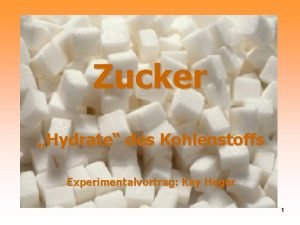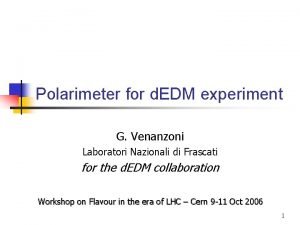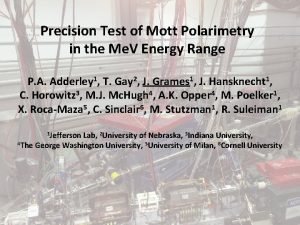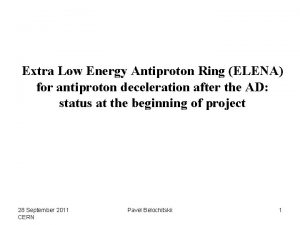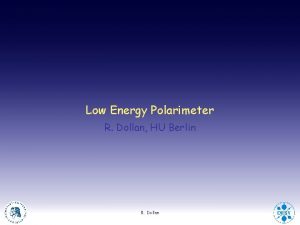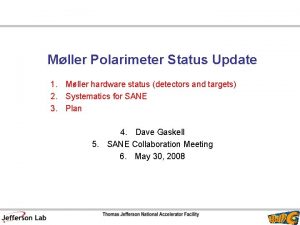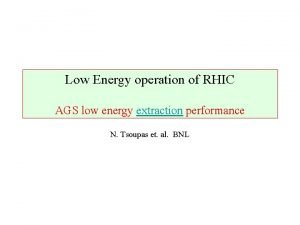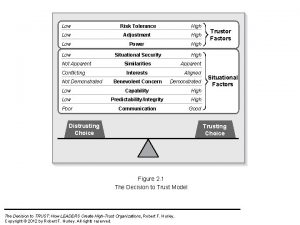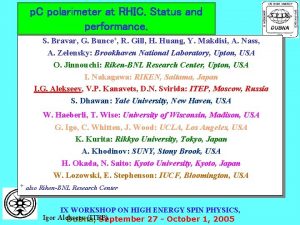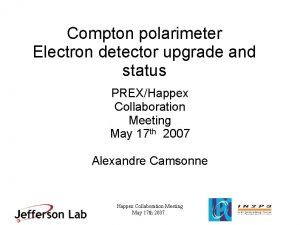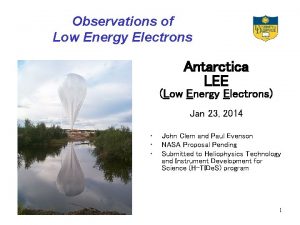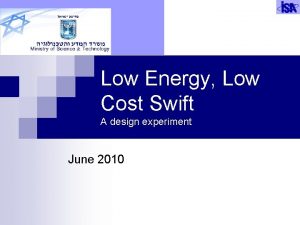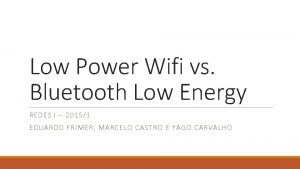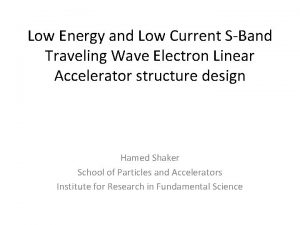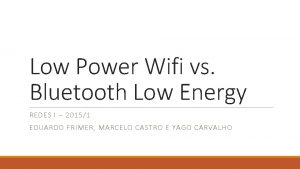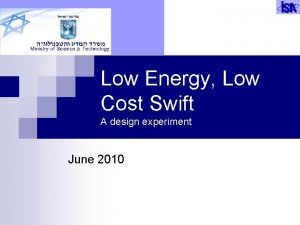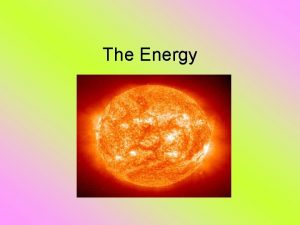Status of New Low Energy Polarimeter at the































- Slides: 31

Status of New Low Energy Polarimeter at the Nuclotron R. A. Kuzyakin, V. V. Fimushkin, M. V. Kulikov, L. V. Kutuzova, Yu. V. Prokofichev, A. M. Shumkov, A. V. Averyanov, D. O. Krivenkov Joint Institute for Nuclear Research, Dubna

General view of the NICA facility Physics with polarized light ion beams is considered as an important part of the NICA program. 2

NICA operation in Polarized Mode Polarized dd – collisions: SPI→ LU-20 → Nuclotron → Collider Polarized pp – collisions: SPI→ LU-20 → Nuclotron → Collider 3

Source of Polarized Ions (SPI) for the JINR accelerator complex (Nuclotron, NICA) Low Energy Beam Transfer (LEBT) SPI Radio Frequency Quadrupole (RFQ) SPI will be used for the NICA-project scientific program implementation

Implementation of polarization program F 3 -polarimeter LEP at LU-20 Polarimeter at Nuclotron ring 5

Bending Magnet and Old LEP Bending Magnet From LU-20 Old LEP Beam Transfer to the Nuclotron 6

Old Low Energy Polarimeter (LEP) Details Vector part Polarimeter Vacuum chamber Tensor part Two independent parts of polarimeter Electronics and DAQ 7

Scheme of the Old LEP for the Vector Polarization Mode LEP for the vector polarization measurements (left – outline, right – photo). 1 – ion transfer; 2 – bellows; 3, 4 – Mylar windows; 5 – vacuum chamber; 6 – movable hermetic volume with collimators A, B, C, D; 7 – silicon detectors (Thickness - 55 μm). Sizes of collimators: А, В – 1, 3 × 7, 4 [mm]; С – 1, 3 × 12, 5 [mm]; D – 2, 5 × 12, 7 [mm]. 8

Old LEP Details The reaction using for the vector polarization measurements is Primary beam energy ~ 10 Me. V Energy after Mylar windows ~ 6. 9 Me. V Energy of scattered (15°) deuterons ~ 6. 7 Me. V Energy of recoil (15°) α-particles ~ 5. 7 Me. V Deuteron energy on the detectors ~ 6. 5 Me. V α-particle energy on the detectors ~ 4. 5 Me. V Ed ~ 6. 7 Me. V A y = 0. 28 Analyzing power of the reaction at the deuterons scattering angle θcms = 150⁰ 9

Old LEP for Tensor Polarization Mode Ep = 20 Me. V Beam LEP for tensor polarization mode (left – photo , right – outline). 10

Old LEP for Tensor Polarization Mode Tensor polarization measurements are based on the following reaction: Ep = 20 Me. V Ed ≈ 6 Me. V T 20 ≈ -1. 3 T 20 component energy dependence of the analyzing power matrix. 11

Motivation for New LEP 12

Proposed Scheme of New Low Energy Polarimeter Vector Mode θcms = 150 o A y = 0. 3 D 1 3 He 15° 112° D 2 Recoil 3 He deuteron 10 Me. V 13

14

Proposed Scheme of New Low Energy Polarimeter Tensor Mode Vector Mode θcms = 150 o A y = 0. 3 θ = 0 o Т 20 = -1. 2 D 1 3 He 112° Recoil 3 He 15° T D 2 deuteron 10 Me. V daughter proton 20 Me. V 15

16

Proposed Scheme of New Low Energy Polarimeter Vector Mode Tensor Mode θcms = 150 o A y = 0. 3 θcms = 80 o A y = 0. 3 P 1 D 1 3 He 63° 15° 112° 3 He Recoil deuteron 10 Me. V proton 5 Me. V daughter proton 20 Me. V θ = 0 o Т 20 = -1. 2 T 50° D 2 P 2 17

18

Proposed Scheme of New Low Energy Polarimeter P 1 D 1 3 He 63° 112° 15° T 50° D 2 Recoil 3 He deuteron 10 Me. V proton 5 Me. V daughter proton 20 Me. V P 2 19

New Low Energy Polarimeter Location Bending Magnet Transfer to Booster From LU-20 Transfer to Nuclotron Dipole Magnet 20

View of New Low Energy Polarimeter DM Fastening Cross Faraday cup TM Pump Vacuum Gate Dipole Magnet TM Pump VC Fastening Vacuum Chamber 21

View of New Low Energy Polarimeter From LU-20 To Booster 17° 34° To Vacuum Chamber 22

View of Dipole Magnet Coils 56 mm Dipole Magnet � 346 mm 22° 34° Vacuum Chamber of Dipole Magnet 23

View of Dipole Magnetic field for different particle energies Energy per nucleon E, Me. V/nucleon Particle Magnetic field (theory) Bт, G Magnetic field (modeling/ experiment) Bм, G Coils current Iм, А Turn radius (theory) Rт, mm 5 p 2905 2800 / 2830 124 1112 5 d 5808 5615 / 5700 249 1112 7 p 3437 3319 / 3350 147 1112 7 d 6872 6648 / 296 1112 13 p 4684 4538 / 4600 201 1112 24

View of Polarimeter Target Spherical mylar vessel Cylindrical mylar vessel 3 He 3 He Radius – 50 mm, Height – 70 mm 25

View of New Low Energy Polarimeter Detector Collimators Detectors Plate 3 He Collimator Detector Target 26

Current Status • Old low energy polarimeter was removed • Fabrication and ordering of basic parts of new polarimeter is in progress • Test runs are possible since next year (it’s not necessary to run Nuclotron cryogenic system to get beam on the LINAC output) • It is suggested to use usual silicon and pixel detectors • The use of solid target – deuterated titanium – is also considered 27

Thanks for your attention! 28

29

30

31
 Furanosen
Furanosen Polarimeter
Polarimeter Mott polarimeter
Mott polarimeter Mid = low + (high - low) / 2
Mid = low + (high - low) / 2 Director communication style
Director communication style High precision vs high accuracy
High precision vs high accuracy Low voltage = low hazard
Low voltage = low hazard Energy energy transfer and general energy analysis
Energy energy transfer and general energy analysis Energy energy transfer and general energy analysis
Energy energy transfer and general energy analysis Low energy capacitor discharge welding
Low energy capacitor discharge welding Low energy antiproton ring
Low energy antiproton ring Low energy precision application
Low energy precision application Status fridge is
Status fridge is Hát kết hợp bộ gõ cơ thể
Hát kết hợp bộ gõ cơ thể Slidetodoc
Slidetodoc Bổ thể
Bổ thể Tỉ lệ cơ thể trẻ em
Tỉ lệ cơ thể trẻ em Voi kéo gỗ như thế nào
Voi kéo gỗ như thế nào Thang điểm glasgow
Thang điểm glasgow Hát lên người ơi
Hát lên người ơi Các môn thể thao bắt đầu bằng tiếng nhảy
Các môn thể thao bắt đầu bằng tiếng nhảy Thế nào là hệ số cao nhất
Thế nào là hệ số cao nhất Các châu lục và đại dương trên thế giới
Các châu lục và đại dương trên thế giới Công thức tính thế năng
Công thức tính thế năng Trời xanh đây là của chúng ta thể thơ
Trời xanh đây là của chúng ta thể thơ Mật thư anh em như thể tay chân
Mật thư anh em như thể tay chân Làm thế nào để 102-1=99
Làm thế nào để 102-1=99 Phản ứng thế ankan
Phản ứng thế ankan Các châu lục và đại dương trên thế giới
Các châu lục và đại dương trên thế giới Thể thơ truyền thống
Thể thơ truyền thống Quá trình desamine hóa có thể tạo ra
Quá trình desamine hóa có thể tạo ra Một số thể thơ truyền thống
Một số thể thơ truyền thống
